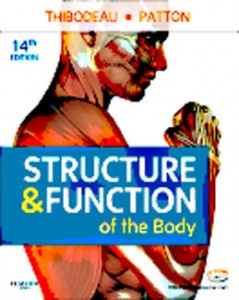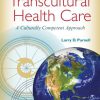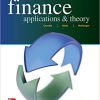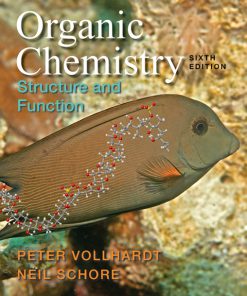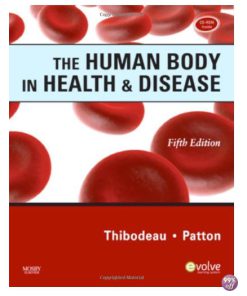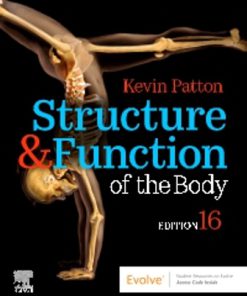Test Bank for Structure and Function of the Body, 14th Edition: Thibodeau
$35.00 Original price was: $35.00.$26.50Current price is: $26.50.
Test Bank for Structure and Function of the Body, 14th Edition: Thibodeau
Instant download Test Bank for Structure and Function of the Body, 14th Edition: Thibodeau pdf docx epub after payment.
Chapter 06: The Skeletal System Test Bank
MULTIPLE CHOICE
1. The red bone marrow is important in the skeletal function of:a. protectionb. supportc. hematopoiesisd. storage
ANS: C DIF: Memorization REF: Page: 110TOP: Functions of the skeletal system
2. Which of the following is not a function of the skeletal system?a. movementb. calcium storagec. blood cell formationd. all of the above are functions of the skeletal system
ANS: D DIF: Memorization REF: Page: 110TOP: Functions of the skeletal system
3. The humerus is an example of:a. a short boneb. a long bonec. a flat boned. an irregular bone
ANS: B DIF: Memorization REF: Page: 110TOP: Types of bones
4. The wrist bone is an example of:a. a short boneb. a long bonec. a flat boned. an irregular bone
ANS: A DIF: Memorization REF: Page: 110TOP: Types of bones
5. The bones of the spine are examples of:a. a short boneb. a long bonec. a flat boned. an irregular bone
ANS: D DIF: Memorization REF: Page: 110TOP: Types of bones
6. The hollow shaft of a long bone is called the:a. diaphysisb. epiphysesc. periosteumd. endosteum
ANS: A DIF: Memorization REF: Page: 110TOP: Structure of long bones
7. The thin, fibrous membrane that lines the medullary cavity is called the:a. diaphysisb. epiphysisc. periosteumd. endosteum
ANS: D DIF: Memorization REF: Page: 111TOP: Structure of long bones
8. The strong, fibrous membrane covering the shaft of the long bone is called the:a. diaphysisb. epiphysisc. periosteumd. endosteum
ANS: C DIF: Memorization REF: Page: 110TOP: Structure of long bones
9. The ends of long bones are called the:a. diaphysisb. epiphysisc. periosteumd. endosteum
ANS: B DIF: Memorization REF: Page: 110TOP: Structure of long bones
10. Trabeculae are:a. needlelike threads of spongy boneb. the basic structure of cartilagec. the basic structure of compact boned. the basic structure of bone marrow
ANS: A DIF: Memorization REF: Page: 111TOP: Microscopic structure of bone and cartilage
11. Another name for the Haversian system is:a. central canalb. lacunaec. canaliculid. osteon
ANS: D DIF: Memorization REF: Page: 111TOP: Microscopic structure of bone and cartilage
12. The bone cells in the Haversian system are found in little spaces called:a. central canalb. canaliculic. lacunaed. none of the above
ANS: C DIF: Memorization REF: Page: 112TOP: Microscopic structure of bone and cartilage
13. Nutrients pass from the blood vessels to the bone cells by way of the:a. central canalb. canaliculic. lacunaed. lamella
ANS: B DIF: Memorization REF: Page: 112TOP: Microscopic structure of bone and cartilage
14. The bone-forming cells are called:a. osteoclastsb. osteocytesc. osteoblastsd. chondrocytes
ANS: C DIF: Memorization REF: Page: 113TOP: Bone formation and growth
15. Cartilage cells are called:a. osteoclastsb. osteocytesc. osteoblastsd. chondrocytes
ANS: D DIF: Memorization REF: Page: 112TOP: Microscopic structure of bone and cartilage
16. The bone-resorbing cells are called:a. osteoclastsb. osteocytesc. osteoblastsd. chondrocytes
ANS: A DIF: Memorization REF: Page: 113TOP: Bone formation and growth
17. As long as this is present in a bone, bone growth can continue.a. diaphysisb. epiphyseal platec. epiphysisd. osteoclasts
ANS: B DIF: Memorization REF: Page: 115TOP: Bone formation and growth
18. Which bone is not part of the axial skeleton?a. ribsb. vertebraec. carpal boned. sternum
ANS: C DIF: Application REF: Page: 123 TOP: Appendicular skeleton—Upper extremity
19. Which bone is not part of the appendicular skeleton?a. humerusb. ulnac. tibiad. hyoid bone
ANS: D DIF: Application REF: Page: 116 TOP: Divisions of skeleton
20. Which bone does not contain one of the paranasal sinuses?a. mandibleb. maxillaryc. frontald. ethmoid
ANS: A DIF: Memorization REF: Page: 119TOP: Axial skeleton—Skull
21. The upper jaw bone is called the:a. zygomaticb. maxillac. mandibled. none of the above
ANS: B DIF: Memorization REF: Page: 117TOP: Table 6-2—Bones of the skull
22. The cheekbone is called the:a. zygomaticb. maxillac. mandibled. none of the above
ANS: A DIF: Memorization REF: Page: 117TOP: Table 6-2—Bones of the skull
23. The bone at the back of the skull is called the:a. temporalb. parietalc. sphenoidd. none of the above
ANS: D DIF: Memorization REF: Page: 117TOP: Table 6-2—Bones of the skull
24. The section of the vertebral column that contains the most vertebrae is the:a. cervical sectionb. thoracic sectionc. lumbar sectiond. sacrum section
ANS: B DIF: Memorization REF: Page: 117TOP: Table 6-3—Bones of the vertebral column
25. Ribs that attach individually to the sternum by way of the costal cartilage are:a. true ribsb. false ribsc. floating ribsd. none of the above
ANS: A DIF: Memorization REF: Page: 121 |Page: 122TOP: Thorax
26. Ribs that do not attach to costal cartilage at all are:a. true ribsb. false ribsc. floating ribsd. none of the above
ANS: C DIF: Memorization REF: Page: 121| Page: 122TOP: Thorax
27. The two bones of the lower arm are the:a. tibia and fibulab. femur and humerusc. ulna and radiusd. none of the above
ANS: C DIF: Memorization REF: Page: 123TOP: Upper extremity
28. The two bones of the lower leg are the:a. tibia and fibulab. femur and humerusc. ulna and radiusd. none of the above
ANS: A DIF: Memorization REF: Page: 126TOP: Lower extremity
29. The phalanges are the bones of the:a. fingersb. wristsc. toesd. both a and c above
ANS: D DIF: Memorization REF: Page: 124|Page: 126TOP: Upper extremity and Lower extremity
30. The metacarpals are the bones of the:a. wristb. footc. ankled. none of the above
ANS: D DIF: Memorization REF: Page: 123|Page: 124TOP: Upper extremity
31. The tarsals are the bones of the:a. wristb. footc. ankled. none of the above
ANS: C DIF: Memorization REF: Page: 126TOP: Lower extremity
32. The bone of the thigh is the:a. ulnab. radiusc. humerusd. femur
ANS: D DIF: Memorization REF: Page: 124TOP: Lower extremity
33. A suture is an example of a(n):a. amphiarthrotic jointb. synarthrotic jointc. diarthrotic jointd. none of the above
ANS: B DIF: Application REF: Page: 128 TOP: Joints (articulations)
34. The knee is an example of a(n):a. amphiarthrotic jointb. synarthrotic jointc. diarthrotic jointd. none of the above
ANS: C DIF: Application REF: Page: 129 TOP: Joints (articulations)
35. The elbow is an example of a(n):a. amphiarthrotic jointb. synarthrotic jointc. diarthrotic jointd. none of the above
ANS: C DIF: Application REF: Page: 129 TOP: Joints (articulations)
36. Which of the following is not a type of bone?a. roundb. flatc. longd. short
ANS: A DIF: Memorization REF: Page: 110TOP: Types of bones
37. In the adult skeleton, red bone marrow is found in the:a. diaphysisb. medullary canalc. epiphysisd. endosteum
ANS: C DIF: Memorization REF: Page: 110TOP: Structure of long bones
38. Which of the following statements is true of both bone and cartilage?a. They both contain more intercellular matrix than cells.b. Both bone and cartilage cells are supplied with food and oxygen through canaliculi.c. Both bone and cartilage cells are located in lacunae.d. Both a and c are true.
ANS: D DIF: Memorization REF: Page: 112 |Page: 113TOP: Microscopic structure of bone and cartilage
39. Which of the following statements is not true of ribs?a. All ribs attach to vertebrae.b. All ribs attach to the sternum.c. There are three pairs of false ribs.d. All of the above are true of ribs.
ANS: B DIF: Memorization REF: Page: 122TOP: Thorax
40. The total number of phalanges in the body is:a. 14b. 28c. 56d. 84
ANS: C DIF: Application REF: Page: 124 TOP: Table 6-5—Bones of the upper extremities | Table 6-6—Bones of the lower extremities
41. Which bone is not part of the coxal bone?a. sacrumb. pubisc. ischiumd. ilium
ANS: A DIF: Memorization REF: Page: 124TOP: Table 6-6—Bones of the lower extremities
42. Moving from superficial to deep in a bone, the parts of the bone would be encountered in which sequence?a. periosteum, endosteum, medullary cavityb. endosteum, periosteum, medullary cavityc. periosteum, medullary cavity, endosteumd. endosteum, medullary cavity, periosteum
ANS: A DIF: Application REF: Page: 110|Page: 111 TOP: Structure of long bones
43. The lambdoidal suture is formed by the joining of the:a. occipital bone and the temporal bonesb. temporal bones and the frontal bonec. parietal bones and the occipital boned. parietal bones and the frontal bone
ANS: C DIF: Memorization REF: Page: 119TOP: Skull
44. Going from superior to inferior, the regions of the spine would be in which order?a. cervical, thoracic, sacrum, coccyx, lumbarb. cervical, thoracic, lumbar, sacrum, coccyxc. cervical, lumbar, thoracic, coccyx, sacrumd. cervical, thoracic, lumbar, coccyx, sacrum
ANS: B DIF: Application REF: Page: 120 TOP: Spine (vertebral column)
45. Straightening a bent elbow is:a. flexionb. rotationc. abductiond. extensione. adductionf. circumduction
ANS: D DIF: Memorization REF: Page: 131TOP: Table 6-7—Types of joint movements
46. Moving part of the body away from the midline of the body is:a. flexionb. rotationc. abductiond. extensione. adductionf. circumduction
ANS: C DIF: Memorization REF: Page: 132TOP: Table 6-7—Types of joint movements
47. Which of the following reduces the angle of a joint?a. flexionb. rotationc. abductiond. extensione. adductionf. circumduction
ANS: A DIF: Memorization REF: Page: 131TOP: Table 6-7—Types of joint movements
48. Moving the arm in a circle around the shoulder joint is:a. flexionb. rotationc. abductiond. extensione. adductionf. circumduction
ANS: F DIF: Memorization REF: Page: 132TOP: Table 6-7—Types of joint movements
49. Moving part of the body toward the midline of the body is:a. flexionb. rotationc. abductiond. extensione. adductionf. circumduction
ANS: E DIF: Memorization REF: Page: 132TOP: Table 6-7—Types of joint movements
50. Bending the elbow is:a. flexionb. rotationc. abductiond. extensione. adductionf. circumduction
ANS: A DIF: Memorization REF: Page: 131TOP: Table 6-7—Types of joint movements
51. Which of the following increases the angle of a joint?a. flexionb. rotationc. abductiond. extensione. adductionf. circumduction
ANS: D DIF: Memorization REF: Page: 131TOP: Table 6-7—Types of joint movements
52. Which of the following spins one bone relative to another?a. flexionb. rotationc. abductiond. extensione. adductionf. circumduction
ANS: B DIF: Memorization REF: Page: 131TOP: Table 6-7—Types of joint movements
53. The primary organ of the skeletal system is:a. cartilageb. bonec. bone and cartilaged. bone, cartilage, and the joints
ANS: B DIF: Memorization REF: Page: 109TOP: Introduction
54. Which of the following is not true of calcitonin?a. It is made in the thyroid gland.b. It increases blood calcium.c. It decreases blood calcium.d. It increases calcium in the bone.
ANS: B DIF: Memorization REF: Page: 110TOP: Storage
55. Which of the following is not true of PTH?a. It is made in the parathyroid gland.b. It increases blood calcium.c. It decreases blood calcium.d. It decreases bone calcium.
ANS: C DIF: Memorization REF: Page: 110TOP: Storage
56. . A treatment method for osteoporosis, a condition where there is too little calcium in the bone, might be to:a. stimulate the release of calcitonin from the parathyroid glandb. stimulate the release of PTH from the thyroid glandc. stimulate the release of calcitonin from the thyroid glandd. none of the above would be a possible method of treatment
ANS: C DIF: Memorization REF: Page: 110TOP: Storage
57. A bone that may develop in a tendon is called a(n):a. sesamoid boneb. irregular bonec. long boned. none of the above would develop in a tendon
ANS: A DIF: Memorization REF: Page: 110TOP: Types of bones
58. The diploe:a. is found in the medullary cavityb. is the outer layer of a long bonec. is the inner layer of a long boned. is the middle layer of a flat bone
ANS: D DIF: Memorization REF: Page: 111TOP: Structure of flat bones
59. Which of the following is not true of the male skeleton?a. The bones tend to be larger than the female skeleton.b. The pelvic opening is wider than the female pelvic opening.c. The markings on the bones are larger and more distinct than in the female.d. All of the above are true of the male skeleton.
ANS: B DIF: Memorization REF: Page: 127TOP: Differences between a man’s and a woman’s skeleton
TRUE/FALSE
1. The storage of calcium is an important function of the skeletal system.
ANS: T DIF: Memorization REF: Page: 110TOP: Functions of the skeletal system
2. The red bone marrow contributes to the support function of the skeletal system.
ANS: F DIF: Memorization REF: Page: 110TOP: Functions of the skeletal system
3. The carpals are an example of short bones.
ANS: T DIF: Memorization REF: Page: 110TOP: Types of bones
4. The vertebrae are examples of flat bones.
ANS: F DIF: Memorization REF: Page: 110TOP: Types of bones
5. The frontal bone of the skull is an example of an irregular bone.
ANS: F DIF: Memorization REF: Page: 110TOP: Types of bones
6. The diaphysis is the hollow shaft of the long bone.
ANS: T DIF: Memorization REF: Page: 110TOP: Structure of long bones
7. The articular cartilage covers and cushions the ends of the bones.
ANS: T DIF: Memorization REF: Page: 1110TOP: Structure of long bones
8. The periosteum lines the medullary cavity.
ANS: F DIF: Memorization REF: Page: 111TOP: Structure of long bones
9. The epiphysis is the hollow area in the shaft of the bone where marrow is stored.
ANS: F DIF: Memorization REF: Page: 110TOP: Structure of long bones
10. The needlelike threads of spongy bone are called trabeculae.
ANS: T DIF: Memorization REF: Page: 111TOP: Microscopic structure of bone and cartilage
11. The concentric rings surrounding the central canal of an osteon are called lamella.
ANS: T DIF: Memorization REF: Page: 111TOP: Microscopic structure of bone and cartilage
12. Canaliculi are small canals that help supply the bone cells with food and oxygen.
ANS: T DIF: Memorization REF: Page: 112TOP: Microscopic structure of bone and cartilage
13. The lacuna is a large canal in the center of the osteon that contains a blood vessel.
ANS: F DIF: Memorization REF: Page: 112TOP: Microscopic structure of bone and cartilage
14. Chondrocytes are cartilage cells.
ANS: T DIF: Memorization REF: Page: 112TOP: Microscopic structure of bone and cartilage
15. Osteoclasts are the bone-forming cells.
ANS: F DIF: Memorization REF: Page: 113TOP: Bone formation and growth
16. Osteoblasts are the bone-resorbing cells.
ANS: F DIF: Memorization REF: Page: 113TOP: Bone formation and growth
17. Most of the bones of the body begin as cartilage.
ANS: T DIF: Memorization REF: Page: 115TOP: Bone formation and growth
18. As long as the epiphyseal plate remains between the diaphysis and epiphysis, bone growth can continue.
ANS: T DIF: Memorization REF: Page: 115TOP: Bone formation and growth
19. The “soft spots” in a baby’s skull are referred to as fontanels.
ANS: T DIF: Memorization REF: Page: 119TOP: Skull
20. Osteoporosis is a weakening of the bone and occurs most often in women of childbearing age.
ANS: F DIF: Memorization REF: Page: 115TOP: Health and Well-Being: Osteoporosis
21. Vitamin C supplements are sometimes given to women to help prevent osteoporosis.
ANS: F DIF: Memorization REF: Page: 115TOP: Health and Well-Being: Osteoporosis
22. An improperly treated epiphyseal fracture can result in the affected limb being shorter than normal.
ANS: T DIF: Memorization REF: Page: 119TOP: Clinical Application: Epiphyseal Fracture
23. The bones of the middle ear are part of the axial skeleton.
ANS: T DIF: Memorization REF: Page: 117TOP: Skull
24. There are more bones in the axial skeleton than in the appendicular skeleton.
ANS: F DIF: Memorization REF: Page: 117TOP: Table 6-1—Main parts of the skeleton
25. The occipital bone is the bone in the back of the skull.
ANS: T DIF: Memorization REF: Page: 117TOP: Table 6-2—Bones of the skull
26. The maxilla is the bone of the lower jaw.
People also search:
Structure and Function of the Body
Structure and Function of the Body Thibodeau
Structure and Function of the Body Thibodeau 14th
Structure and Function of the Body Thibodeau 14th Test Bank
Test Bank for Structure and Function of the Body, 14th Edition: Thibodeau Download
You may also like…
Test Bank
Test Bank for Memmler’s Structure and Function of the Human Body 10th Edition Jason James Taylor


